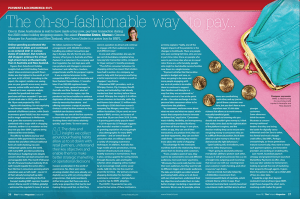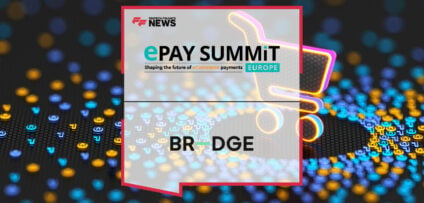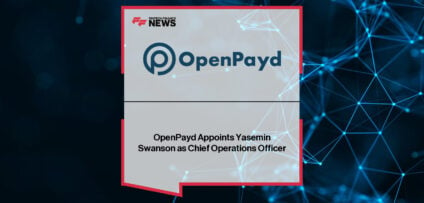Breaking News

Exclusive: ‘The oh-so-fashionable way to pay…’ – Francine Ereira, Klarna in “The Fintech Magazine”
One in three Australians is said to have made a buy now, pay later transaction during the 2020 online holiday shopping season. We asked Francine Ereira, Klarna’s General Manager for Australia and New Zealand, why Down Under is a poster boy for BNPL
Online spending accelerated the world over in 2020, and continued as we entered 2021 in various states of lockdown. But nowhere did shoppers embrace the virtual high street more enthusiastically than in Australia and New Zealand.
Figures from Salesforce’s Holiday Insights Hub and 2020 Holiday Predictions report show ecommerce growth Down Under was the highest in the world, at 107 per cent, in Q3 of 2020. According to the report, the region’s retailers are seeing year-on-year growth across every metric: revenue, online traffic and order size.
Based on its own, separate analysis, Australia Post predicted that online purchases will have exceeded 15 per cent of total retail sales in 2020, years ahead of the 16 per cent projected by 2025.
Against this backdrop, it’s not surprising to see Amazon rapidly expanding its network of fulfilment centres, while Dutch ecommerce giant VidaXL has also recently built a mega warehouse in Melbourne. And, given the economic uncertainty, combined with a major shift in shopping channels, neither is it a revelation to find buy now pay later (BNPL) options being embraced like never before.
The offer to ‘try before you buy’ and spread or defer payments for purchases, interest free and often without traditional forms of credit checking, has seen widespread uptake across the world, with many BNPL providers positioning themselves as ‘budgeting tools’, despite concerns that they can lead consumers into unmanageable debt. This month (February), the UK’s Financial Conduct Authority (FCA) said it would regulate the sector after a four-fold rise in consumers accessing what’s sometimes seen as ‘soft credit’ – one in 10 of them already having built up debt arrears elsewhere, according to the FCA.
Europe’s leading BNPL operator Swedish unicorn Klarna (worth $11billion globally) – welcomed the regulator’s move. It serves 90 million customers through arrangements with 200,000 merchants handling one million transactions per day in Europe, the UK, the US and, since January of last year, in Australia and New Zealand. In a statement, the company said that ‘regulation has not kept pace with new products and changes in consumer behaviour’ and called for a ‘modern, proportionate and fit-for-purpose’ regime.
It was a relative latecomer to the competitive BNPL market in Australia and New Zealand. Nevertheless, 12 months later it has 500,000 registered users.
Francine Ereira, general manager for Australia and New Zealand, who led Klarna’s move into the region, says the pandemic has forced retailers to embrace digitisation of their businesses, sometimes more by necessity than desire – and offering consumers a range of payment choices is critical to drive revenue as they establish new business models.
“Australia was one of the first countries to move into quite stringent lockdowns, shutting down retail stores relatively quickly,” says Ereira. “So we’ve seen a massive acceleration in the world of ecommerce. Yes, there were some amazing retailers that were already very digitally savvy, with very strong digital programmes, that quite seamlessly shifted into gear. But there was also a really large proportion that had to start making things work fast, so that they were in a position to attract and continue to engage with their audiences in new and different ways.”
In one week of December, she says, 30 per cent of Australians completed a buy now pay later transaction online, compared to 10 per cent just 12 months previously.
“The shift in consumer behaviour [to shopping online] has meant that retailers have had to evolve. As a company, we want to help with that process and bring a better experience to retailers as well as shoppers,” says Ereira.
Alternative BNPL providers, such as Afterpay, Humm, Zip, Limepay, Bundll, Laybuy and LatitudePay, had already marked out their territory before Klarna arrived. Afterpay has roughly 3.4 million active customers in Australia, while Zip and Humm claim about 2.5 million each. According to 2020 data from research company Roy Morgan, more than 12.3 million Australians (59 per cent) are now aware of BNPL services, an increase of more than 20 per cent from 2019. So why is it proving particularly popular here?
A 2019 report by J.P. Morgan suggests that Australia’s market is notable for its growing population of young people – a key demographic for many BNPL providers – and an ‘overall base of consumers that are willing to adopt a variety of emerging ecommerce techniques’. In addition, Australia has huge mobile phone penetration, strong internet infrastructure and enjoys a healthy economy in normal times. There is also a serious appetite for saving money through discounts, sales and loyalty schemes when shopping online, fuelled by an increasingly retail-centric social media. Add into the mix the country’s proximity to China – the ‘primary overseas shopping destination for Australian ecommerce consumers’ – and you have a country ripe for BNPL adoption.
The COVID-19 pandemic has only served to fuel some of these motivators, as Ereira explains: “Sadly, one of the biggest impacts of the pandemic is the changes to livelihoods. There are people who were working full-time, who are now in part-time roles; there are people who were in part-time roles who are in casual roles; there are, unfortunately, people who might’ve had double income families now down to a single income.
“Payment vehicles like Klarna allow people to budget and save, so there are going to be more and more people engaging with our sorts of products to enable them to continue to support their families and lifestyle in a way that they are accustomed to.”
Klarna’s service is free at the point of sale – the value exchange is in the personal data consumers allow to be shared over the platform.
“As consumers, we know more about what we want and what we expect, which means that companies have to innovate to deliver that,” says Ereira. “Consumers want visibility, flexibility, and transparency, and innovative providers like Klarna give them all those things. In one place, within an app, they can see all their transactions, at a product level, they can see their repayments, they can see their credit limits – everything they need to know about the world of shopping.”
The advantage for the merchants manifests itself in the relationship Klarna allows them to develop with customers.
“From a retailers’ point of view, they want to be connected to new and different audiences, more and more,” says Ereira. “Obviously, they work really hard to create their own audiences, but they want to talk to different, bigger and broader audiences. The data and insights we collect around purchasing habits, allow us to sit down with our retail partners, understand their key objectives and enable them to make better strategic marketing or operational decisions. We can see, for example, where stores are cannibalising each other, and say ‘you’ve got all these customers over here, but you don’t have a store anywhere near’. It’s this data richness that allows us to work towards mutually-beneficial goals.
“With regards to knowing who you should and shouldn’t give money to, I think that really comes back to the sophistication of the platform’s engines, and the decision-making they use to ensure we’re not giving money to consumers who are in a difficult financial position. But it does allow us to give money to those that demonstrate the right behaviours.”
Open banking will, she believes, only serve to refine that process.
“That’s going to absolutely enhance everybody’s ability to protect each other, because it will give businesses like us a lot of insight into outgoings and incomings that we can use with our existing know your customer credit checking, and other resources,” says Ereira.
Klarna entered Australia helped by a $300million investment from Commonwealth Bank of Australia, which embeds Klarna within its app. Rival National Australia Bank recently launched a no-interest credit card that aims to attract younger customers. Some observers think the move illustrates a concern among traditional lenders that they are losing the battle for digitally-savvy millennials and Gen Zers to other, less formal and much cheaper credit offers, like BNPL. Perhaps unsurprisingly, as those generations mature economically, they want to retain such payment options, and innovative providers are working on enabling this.
Last month, Australian paytech Limepay and proptech Domain launched MarketNow Payments to offer a buy now pay later solution to homeowners looking to spread the cost of marketing their property through agents. It gives them the option to defer up to US$25,000 of fees to a later date.
It could be a sign that, beyond Louboutin heels and Gucci gear, BNPL might have changed the short-term, revolving credit market for good.
This article was published in The Fintech Magazine #19, Page 26-27
People In This Post
Companies In This Post
- Business Show Media, Organizer of the World’s Largest Business Events, Reimagines the White Label World Expo for an Exciting New Era Read more
- The Finalists Announced for the 2025 FF Awards Read more
- How the New Generation of Digital Wallets Will Upend Fintech Read more
- EXCLUSIVE: “‘Shadow Boxing'” – Rajul Sood, Acuity Knowledge Partners in ‘The Fintech Magazine’ Read more
- Vennre Builds Wealth Tech Platform Read more






















